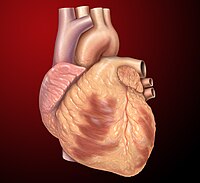
Photo from wikipedia
To the Editor: I read with interest the article by Rubin et al.1 which highlights two important topics: postcardiac transplant conduction abnormalities requiring permanent pacemaker (PPM) and tricuspid regurgitation (TR).… Click to show full abstract
To the Editor: I read with interest the article by Rubin et al.1 which highlights two important topics: postcardiac transplant conduction abnormalities requiring permanent pacemaker (PPM) and tricuspid regurgitation (TR). Patients who underwent cardiac transplantation between 2013 and 2017, with and without tricuspid annular reduction using the DeVega annuloplasty (DVA), were analyzed. Despite waiting an average of 21 days for recovery of conduction, PPM implant was required in 2.5%–3% of the entire cohort by day 30. Albeit the numbers were small, <1% ventricular pacing (VP) was noted at 1-year follow-up in those implanted for complete heart block. That being said, PPM for sinus node dysfunction did not necessarily eliminate the need for future VP, as one patient whose PPM indication was sinus node dysfunction also had 15% VP at 1-year follow-up.1 Additionally, ~3% of the without DVA group developed moderate or greater TR, compared to none in the DVA group at 1 year. In the discussion,1 the authors mention the following donor and recipient risk factors for PPM requirement post cardiac transplant: older donor age, prolonged donor ischemic time, preoperative amiodarone use, and allograft rejection. Additionally, concerns regarding PPM infection risk in the setting of immunosuppressive drugs and hazards of endomyocardial biopsy were raised. This is relevant because immunosuppression is most intense, and biopsy frequency highest, early after transplant at the time the patients underwent PPM implant in this study. The new heart allocation system was designed to shorten waitlist times for the sickest recipients.2 However, broader geographical organ sharing of a limited donor pool2 may result in the unintended consequence of transplant centers having to decide between utilization of less ideal donors (older, farther away, less compatible), or waiting for a more ideal donor thereby increasing antiarrhythmic use in certain patients. In 2016, the US Food and Drug Administration approved the Micra transcatheter pacing system (Medtronic Inc) for clinical use.3 The device is wireless, approximately an inch long, with a mean battery life of ~12.5 years. Deployed in the right ventricle via the femoral vein, it eliminates the risks of tricuspid valve leaflet impingement, device pocket hematoma and infection, and iatrogenic TR.3,4 Implantable cardioverter defibrillators are common in patients who undergo cardiac transplant, and complete removal of the leads is not always possible, increasing upper extremity deep venous thrombosis.5 In situations where upper extremity venous access is complex or not feasible, or in those with open or infected chest wounds, the leadless pacemaker is an attractive alternative to conventional PPM. The aforementioned advantages of this technology are significant in the cardiac transplant recipient with an impaired immune system, at risk for iatrogenic TR. Current disadvantages include the inability to pace the right atrium, and inability to percutaneously retrieve the device. Finally, as the field of noninvasive methods to monitor for cardiac allograft rejection expands,6 and the number of endomyocardial biopsies diminishes, hopefully so will the rates of biopsy-induced TR and conduction abnormalities.
Journal Title: ASAIO Journal
Year Published: 2020
Link to full text (if available)
Share on Social Media: Sign Up to like & get
recommendations!